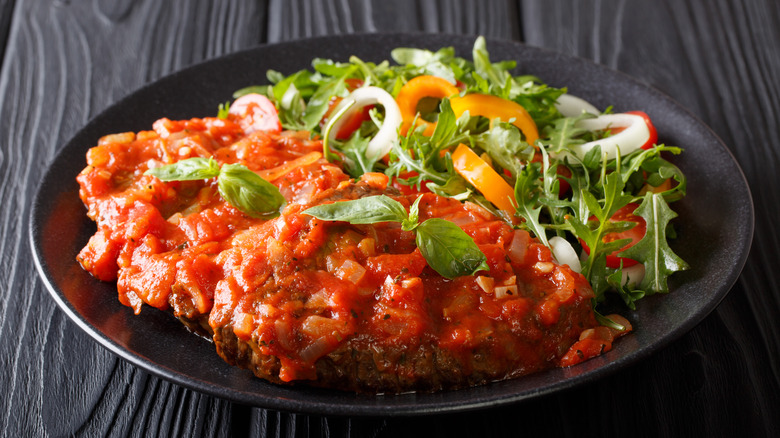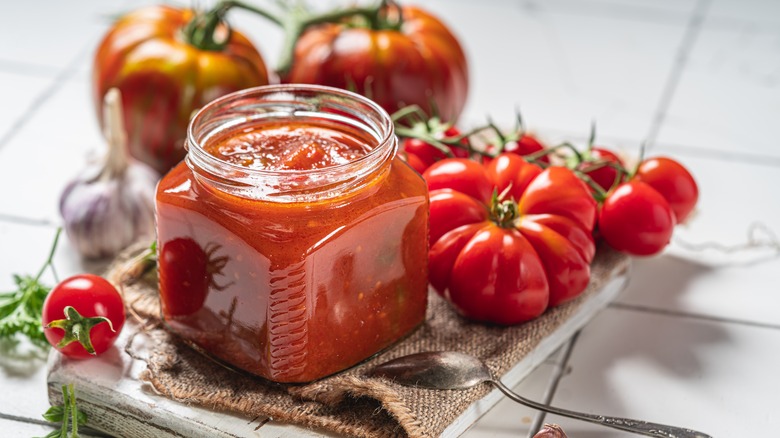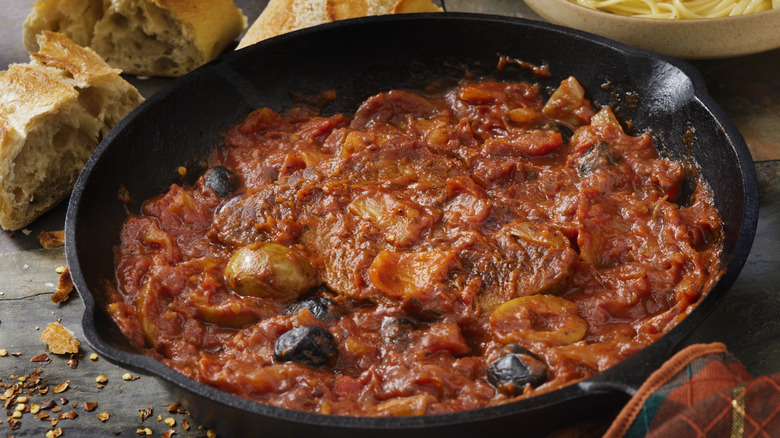The Italian Dish That Gloriously Unites Steak With Leftover Pizza Sauce
With the proliferation of kitchen gadgets like the pizza stone, America's beloved delivery food is no longer just the purview of the local pizzeria. But while a pizza with tomato sauce and a basic homemade dough can be very satisfying, the added effort required to churn out a tasty slice may seem like a hero's task after a long day of work. Thankfully, pizza sauce — like most Italian red sauces — is extremely versatile, so there are plenty of simpler uses for that leftover jar in the fridge.
Enter the carne alla pizzaiola: an Italian dish that marries steak with pizza sauce. It is commonly believed that this dish got its start in Naples, which makes a lot of sense because the Neapolitans are considered the founders of the modern pizza. And their reasoning for creating the dish is the same one that the homemade pizza maker would use today: time. Making fresh pizza dough is a laborious process; it creates a sticky mess in the kitchen and requires several hours to let the dough properly rise. Even Neapolitan bakers from the 1700s wanted an easy dinner now and again.
Traditional pizzaiola uses thinly sliced pieces of beef called fettine di manzo or some other inexpensive beef cut that is braised in tomato sauce. The results are tender, flavorful meat with the traditional taste of pizza and none of the pesky wait for rising dough.
A perfect pizzaiola can be made quickly with simple ingredients
The first step for a pizzaiola is selecting the meat. While the dish can be made with any kind of beef, there are certain cuts that are more conducive to the cooking process. Something expensive like a ribeye or tenderloin, while delicious, is better served as a steak and not an ingredient in a dish smothered in sauce. Whereas cuts like a bottom round roast or sirloin tip steak are not only budget-friendly but also can be sliced thin and stand up to well braising.
The sauce for a pizzaiola should have a few standard ingredients: both whole peeled tomatoes and tomato paste, garlic, olive oil, oregano, and basil — maybe something briny like olives or capers. It basically includes all the same ingredients that are found in a typical pizza sauce. Not only does the acid in the tomato work to tenderize cheaper cuts of beef, making them buttery, melt-in-your-mouth delicious, but that acid also denatures the meat. This allows the flavors of the sauce to sink deep into each bite of beef. It's simple, and it's delicious.
Pizzaiola can be modified and served many different ways
Pizzaiola is an entree that pairs well with a lot of different sides. The most obvious is pasta; the sauce that accompanies the beef works just as well as a pasta sauce as an accouterment to the meat. Other starches like roasted potatoes, turnips, and butternut squash are also excellent sides to sop up all that extra sauce. Vegetables like asparagus, artichokes, zucchini, or eggplant are commonly used in Italian cooking and also pair nicely here.
The pizzaiola itself can also be modified; considering the many pizza sauces that shamelessly break flavor traditions, their inclusion in this dish can create a whole host of variations. Standard pizza sauce can have a number of extra ingredients like olives, mushrooms, peppers, and even anchovies. The pizzaiola also doesn't have to be made with steak, either. With the appropriate adjustments to the recipe, chicken, pork chops, sausage, veal, and even certain hearty vegetables can take the place of beef. Variety and improvisation are some of the beauties of home cooking and Italian food, and this dish in particular lends itself well to that.



